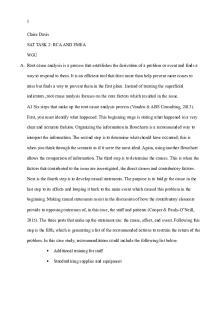Task 2 PDF

| Title | Task 2 |
|---|---|
| Author | Claire Davis |
| Course | Organizational Systems and Quality Leadership |
| Institution | Western Governors University |
| Pages | 8 |
| File Size | 127.7 KB |
| File Type | |
| Total Downloads | 99 |
| Total Views | 157 |
Summary
SAT Task 2 Case Scenario...
Description
1 Claire Davis SAT TASK 2: RCA AND FMEA WGU A. Root cause analysis is a process that establishes the derivation of a problem or event and finds a way to respond to them. It is an efficient tool that does more than help prevent more issues to arise but finds a way to prevent them in the first place. Instead of treating the superficial indicators, root cause analysis focuses on the core factors which resulted in the issue. A1 Six steps that make up the root cause analysis process (Vanden & ABS Consulting, 2013). First, you must identify what happened. This beginning stage is stating what happened in a very clear and accurate fashion. Organizing the information in flowcharts is a recommended way to interpret the information. The second step is to determine what should have occurred; this is when you think through the scenario as if it were the most ideal. Again, using another flowchart allows the comparison of information. The third step is to determine the causes. This is when the factors that contributed to the issue are investigated, the direct causes and contributory factors. Next is the fourth step is to develop casual statements. The purpose is to bridge the cause in the last step to its effects and looping it back to the main event which caused this problem in the beginning. Making causal statements assist in the discussion of how the contributory elements provide to opposing outcomes of, in this case, the staff and patients (Cooper & Pauly-O’Neill, 2015). The three parts that make up the statement are: the cause, effect, and event. Following this step is the fifth, which is generating a list of the recommended actions to restrain the return of the problem. In this case study, recommendations could include the following list below.
Additional training for staff
Standardizing supplies and equipment
2
Establishing new policies
Providing and enabling cognitive aids
Simplifying the process
Placing forcing functions that physically restrict people to make recurrent errors
The last step of the root cause analysis process is to prepare the summary and share it. Developing a final flowchart can help clarify to leaders within the system the next steps to facilitating the changes. A2. Looking at the scenario, Mr. B in the end passed away because of the sedation he received which caused a cardiopulmonary arrest. Many factors were involved that contributed to this result. A causative factor was how much sedation Mr. B received. He was administered 10mg of diazepam, also of 4mg of hydromorphone within 15 minutes. It is standard for hydromorphone to begin working within 10 to 15 minutes intravenously, then its peak is between 15 to 30 minutes. Diazepam has an onset time of 1 to 5 minutes and peaks between 15 to 30 minutes (In Kaye & In Urman, 2014). Besides, this patient was not put on an ECG monitor which is conflicting with policy. If this patient had an ECG monitor on, it could have detected the change in the patient’s heart rhythm that may have happened because of the sedation that was administered. Patients who receive sedation are automatically at higher risk for hypoxia. This patient however was not provided right away during or after they were sedated and there was no nurse to keep watch of them post sedation. Mr. B remained on a continuous pulse oximeter and had automatic blood pressures recurring however his respirations and temperature were never supervised. Policy requires patients to remain on a continuous pulse oximeter, cardiac monitoring, and blood pressures through the entire process once the patient maintains the
3 necessary discharge criteria. In this scenario, the LPN missed to report to the registered nurse the instance of finding the patient’s oxygen saturation at 85%. This should have been reported right away, then effective intervention would have been taken by the nurse. This scenario did not exactly describe how the environment of the floor was on the day this problem occurred, but it sounded like a chaotic shift in the emergency department. They may have been short-staffed and had a heavy workload of patients. Errors are more likely to occur when staffing is not adequate and there is pressure. When Mr. B eventually became sedated, there was only one LPN and RN working and handling three patients. There was a fourth patient in the process of being admitted, it was evident that they failed to call for additional help. This may have contributed to the poor monitoring of Mr. B and contributed to the devastating event of losing him after the sedation was administered. The registered nurse should have requested additional backup before even proceeding to take on their fourth patient. B. When creating an improvement plan, it is greatly advised to establish one within a group of team members. Looking at this case, these members could include the ER charge nurse, the director of nursing, the nursing supervisor, the risk management department, and a respiratory therapist. Taking each one of these members aside, one on one, and having an interview with each of those who were directly involved in this case would reveal exactly what happened. Beyond interviewing, reviewing incident reports, and thoroughly audit the charting. Then, it must be determined what should have occurred correctly. Together as a team, would discuss the causes of all the problems and formulate a causal statement that touches every cause they identified. As mentioned earlier, a casual statement consists of three parts: cause, effect of the cause, and how it connects with the problem. The next part is formulating suggestions to prevent reoccurrence. The team should therefore prepare the overview of the root cause analysis and communicate it to the
4 rest of the staff, leadership, and other responsible members. Some recommended examples of this could include creating a sedation safety checklist mandatory to follow to guarantee essential components such as having an ECG, pulse oximeter, and blood pressure monitor on the patient that they will never be disregarded. B1. Lewin’s change theory is comprised of three phases. They are unfreezing, moving, and refreezing (Cherry & Jacob, 2014). Starting with unfreezing, it means to take notice of the demand for change, for example, by encouraging others to change their previous ways and make sense of the need for change including how the change will be executed. A process improvement team reaches this goal by training staff about the event that caused the problem and how present practices have impacted the event. This team takes the lead in planning changes, create revised staffing checklists, and clear sedation safety guidelines. After introducing these measures, the moving stage phase is the next step which involves the implementation of the guidelines started during the unfreezing stage. Staff will therefore begin to follow the sedation safety guidelines per patients ordered to become sedated in the emergency department and the improved staffing rules. An example of one rule may be to place more staff help when needs on the unit arise. At his stage, leadership must be accessible to surround the staff and guide them through this new process. Lastly, at the freezing stage, all the new changes are integrated into the organization’s standards. C. FMEA, also known as failure mode and effects policy is the method utilized in the documentation of potential failures (Carlson, 2012). It is implemented in healthcare to reduce the potential for harmful errors to arise and enhance the quality of care for better outcomes. C1. In the FMEA method, there are seven phases, starting with pinpointing a process to assess using FMEA. The next stage is to piece together the multidisciplinary team and in the third
5 phase, this group is mandated to disclose all the steps to the process which is being evaluated. The fourth step is when the group recognizes potential failure modes. At the fifth stage, the assignment of the risk priority number, also known as RPN, to each failure mode which signifies the chances of that failure occurring, extremity should that failure occur, and chance of detection (Carlson, 2012). The final step of this method is the assessment of the results and the use of RPN to plan for improvement. Likelihood of Occurrence (1–10)
Likelihood of Detection (1–10)
Severity (1–10)
Risk Priority Number (RPN)
The nurse is unavailable due to being occupied by other tasks or patients.
8
5
5
360
The nurse is not familiar with the sedation policy or poorly educated on using it correctly. The nurse does not know where to look for the sedation narrator or is unfamiliar with how to use it. The proper and appropriate equipment are not all able to be found.
9
3
9
243
5
6
7
210
6
3
6
108
List 4 steps in your Improvement Plan Process *
List 1 Failure Mode per step
1. The registered nurse should be present from the beginning of the preprocedure to the end of the post-procedure. 2. The registered nurse should follow the process of the sedation policy. 3. The registered nurse should be using the sedation narrator.
4. All patients should be monitored by using all the proper and appropriate equipment.
Total RPN: 921
C2. FMEA Table
D. The process of testing the improvement program starts by applying suggestions, such as what the staff is recommending and the suggestions of application sedation safety. A random chart evaluation is a potential resource used to gain the information of the percentage of the time checklist are being used and if it is used as a commendation. According to this scenario, it has
6 been distinguished that the checklist is not being utilized how it has been projected, the changes to the checklist is complete. Therefore, the method is repeated once the team can configure a checklist that works. As when it comes to the recommendations for staffing, we can map out the processes to understand when the emergency department is most popular with a high number of patients. Understanding this flow will benefit staffing in being more accurate in predicting the correct times when to have on more staff to decrease the potential of having cases of death, overall increase the quality of the care, and satisfaction of visitors and patients. E. The role of professional nurses is to promote high-quality care by following the improvement of principles of care. Being able to achieve this high-quality care is by preparing policies to verify that nurses are mandatory to follow through being above average. When patient outcomes are improved, it includes improving the patient regain their strength and overall enhance their whole wellbeing. However, superior leadership in healthcare such as nurse practitioners, physician’s assistants, and medical doctors have the duty of communicating to the rest of the care team their vital role to improve patient outcomes. Professional nurses are able to demonstrate leadership in their practice by encouraging quality of care by advocating for patients. When patients are hospitalized, they can be in their most vulnerable state. When a nurse pays attention to their concerns and be the voice for them when needed, perhaps when a patient is at a compromised state, then this is providing quality care to that patient. Nurses can exemplify patient outcomes by following to the set of protocols to confirm patient safety. By always keeping in mind of the patient’s best interest to their heart, nurses are able to provide caring, empathetic, and safe care. This improves patient outcomes and allows them to trust the nurse that they are taken care of in the best way possible. It is not possible to just have one health care professional treating the patient holistically to improve their
7 outcomes, but it takes an entire team to be effective. Leadership can demonstrate this by using qualitative and quantitative data from credible studies to bring forth into having quality healthcare. By processing and forming policies, they can authorize how quality care is carried out and regulated. Nurses authenticate in influencing quality improvement activities by constantly educating themselves and advancing with the current standards of care. Quality indicators for nurse leaders are examined consistently and are prepared to be changed as needed. E1. The RCA and FMEA processes guide medical professionals to create a path for other healthcare team members to enhance their practice and provide additional input on how these processes can be provided to the healthcare community as a whole. Nurses should carry out and appraise plans and processes repeatedly. As a nurse myself, I am constantly using my critical thinking skills to come up with the best way to assist my patients and are their advocate. These processes are helpful platforms to initiate active changes to transform a better way to increase successful patient outcomes. As a nurse leader on the forefront of patient care, I have seen how these two processes do improve patient overall well-being.
8
References Carlson, C. (2012). Effective FMEAs: Achieving safe, reliable, and economical products and processes using failure mode and effects analysis. Hoboken, N.J: Wiley. Cherry, B., & Jacob, S. (2014). Contemporary Nursing: Issues, Trends, and Management (Vol. 6). (M. Elsevier, Ed.) St. Louis. Cooper, E. E., & Pauly-O’Neill, S. (2015). Use of Root Cause Analysis in Nursing Education: Best Practice from the Quality and Safety Officer. In Kaye, A. D., In Kaye, A. M., & In Urman, R. D. (2014). Essentials of pharmacology for anesthesia, pain medicine, and critical care. Vanden, H., & ABS Consulting. (2013). Root Cause Analysis Handbook: A Guide To Efficient and Effective Incident Investigation (3rd ed., pp. 16-20). Brookfield, Conn.: Rothstein Associates Inc....
Similar Free PDFs

Task 2 - Task 2
- 5 Pages

QHT1 Task 2 - Task 2
- 1 Pages

Task 2 - C226 Task 2
- 7 Pages

D082 Task 2 - Task 2
- 3 Pages

TDT1 Task 2 - Task 2
- 4 Pages

TET1 Task 2 - Task 2
- 4 Pages

DO81 - Task 2 - Task 2
- 5 Pages

C228 Task 2 - Task 2
- 6 Pages

D081 - Task 2 - Task 2
- 2 Pages

D093 Task 2 - task
- 6 Pages

Final CPC TASK 2 - task 2
- 44 Pages

Task 2
- 8 Pages

Task 2
- 10 Pages

C489 Task Two - Task 2
- 7 Pages

CH-C207 Task 2 - task 2
- 7 Pages

C840 Task 2 v1 - Task 2
- 20 Pages
Popular Institutions
- Tinajero National High School - Annex
- Politeknik Caltex Riau
- Yokohama City University
- SGT University
- University of Al-Qadisiyah
- Divine Word College of Vigan
- Techniek College Rotterdam
- Universidade de Santiago
- Universiti Teknologi MARA Cawangan Johor Kampus Pasir Gudang
- Poltekkes Kemenkes Yogyakarta
- Baguio City National High School
- Colegio san marcos
- preparatoria uno
- Centro de Bachillerato Tecnológico Industrial y de Servicios No. 107
- Dalian Maritime University
- Quang Trung Secondary School
- Colegio Tecnológico en Informática
- Corporación Regional de Educación Superior
- Grupo CEDVA
- Dar Al Uloom University
- Centro de Estudios Preuniversitarios de la Universidad Nacional de Ingeniería
- 上智大学
- Aakash International School, Nuna Majara
- San Felipe Neri Catholic School
- Kang Chiao International School - New Taipei City
- Misamis Occidental National High School
- Institución Educativa Escuela Normal Juan Ladrilleros
- Kolehiyo ng Pantukan
- Batanes State College
- Instituto Continental
- Sekolah Menengah Kejuruan Kesehatan Kaltara (Tarakan)
- Colegio de La Inmaculada Concepcion - Cebu